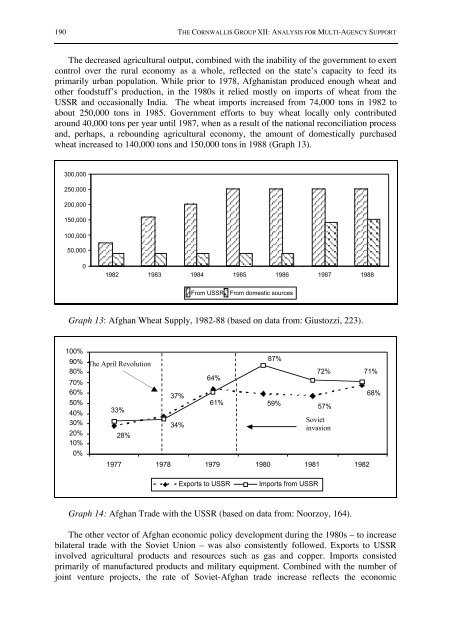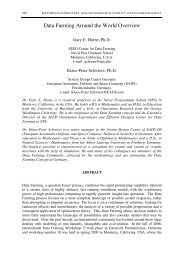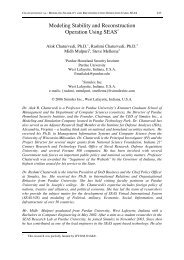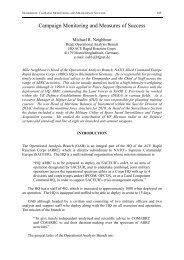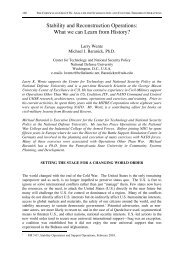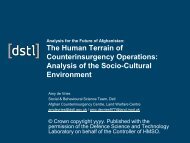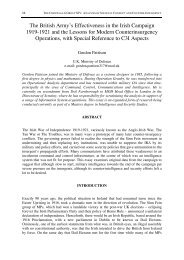MINKOV AND SMOLYNEC: 3-D SOVIET STYLE 189Efforts to expand <strong>the</strong> public sector <strong>in</strong> agriculture failed. The land reforms <strong>in</strong>troduced <strong>in</strong>1978 antagonized farmers and landlords and limited state control of <strong>the</strong> sector. The firstreform – cancel<strong>in</strong>g agricultural loans – did not elim<strong>in</strong>ate <strong>the</strong> farmer’s need for credit. Thesecond reform was an imposition of ceil<strong>in</strong>gs on land ownership and <strong>the</strong> distribution of <strong>the</strong>excess land to small owners or landless peasants. It too was met various practical difficulties,such as scarcity of cultivable land overall, lack of <strong>in</strong>formation on ownership, lack ofcompensation for <strong>the</strong> expropriated land and <strong>the</strong> sanctity of ownership <strong>in</strong> Islamic law. Thegrandiose plans to create thousands of cooperatives also could not be fulfilled. In 1982 <strong>the</strong>irnumber stood at 1,217 and only grew to 1,274 <strong>in</strong> 1984. The creation of new farms decl<strong>in</strong>edsharply <strong>in</strong> 1986, and aga<strong>in</strong> after 1988 (Giustozzi, 294). In 1989, cooperatives only generated1% of all agricultural produce (Giustizzi, 169).The most serious damage to <strong>the</strong> agricultural sector, however, was <strong>the</strong> Red Army’sdecision to destroy <strong>the</strong> mujahid<strong>in</strong> economy as part of its counter<strong>in</strong>surgency strategy.Although military operations by <strong>the</strong> Red Army to prevent <strong>the</strong> mujahid<strong>in</strong> <strong>from</strong> rely<strong>in</strong>g on <strong>the</strong>countryside as an economic and supply base were successful (Rub<strong>in</strong>, 1995, 180-181), asalready mentioned, <strong>the</strong>y also led to hundreds of thousands of casualties, <strong>the</strong> emigration of 5million people to Pakistan and Iran as refugees, <strong>the</strong> emigration of additional 2 million tourban centers, and <strong>the</strong> destruction of 20% of <strong>the</strong> rural villages. As a result of this destruction,<strong>the</strong> abandonment of farms and <strong>the</strong> loss of labour, by 1983 <strong>the</strong> production and yields ofagricultural products decl<strong>in</strong>ed significantly (Farr and Gul, 67). Livestock decreased betweenone to two thirds (Rub<strong>in</strong>, 1995, 227) (Graph 12).40%35%36%30%30%% Farmers25%20%15%10%13%12%24%20%12%5%0%0%1978 1980 1985 1986 1987Reported by Farmers <strong>in</strong> AfghanistanReported by Farmers who left AfghanistanGraph 12: Farmers Report<strong>in</strong>g Destruction of Irrigation by <strong>the</strong> <strong>Soviet</strong> Army (based ondata <strong>from</strong>: Rub<strong>in</strong>, 1995, 228).Faced with a deteriorat<strong>in</strong>g agricultural sector and an antagonized rural population, <strong>the</strong>regime gradually softened its land reform policies. After 1989, all efforts at land reformswere officially abandoned and a guarantee of land ownership was built <strong>in</strong>to <strong>the</strong> constitution(Giustozzi, 169). With <strong>the</strong> decrease of major military operations after 1985, it is believed that<strong>the</strong> agricultural sector was able to rebound, however no data exists to demonstrate this. Itshould be noted that by that time, <strong>the</strong> rural economy no longer provided <strong>the</strong> economic base to<strong>the</strong> resistance. This role was assumed by <strong>the</strong> foreign aid supplied by <strong>the</strong> US and Saudi Arabiaand distributed through Pakistan. This aid made <strong>the</strong> <strong>in</strong>surgency <strong>in</strong>dependent of <strong>the</strong> localeconomy (Rub<strong>in</strong> (1995), 181, 231-232).
190 THE CORNWALLIS GROUP XII: ANALYSIS FOR MULTI-AGENCY SUPPORTThe decreased agricultural output, comb<strong>in</strong>ed with <strong>the</strong> <strong>in</strong>ability of <strong>the</strong> government to exertcontrol over <strong>the</strong> rural economy as a whole, reflected on <strong>the</strong> state’s capacity to feed itsprimarily urban population. While prior to 1978, Afghanistan produced enough wheat ando<strong>the</strong>r foodstuff’s production, <strong>in</strong> <strong>the</strong> 1980s it relied mostly on imports of wheat <strong>from</strong> <strong>the</strong>USSR and occasionally India. The wheat imports <strong>in</strong>creased <strong>from</strong> 74,000 tons <strong>in</strong> 1982 toabout 250,000 tons <strong>in</strong> 1985. Government efforts to buy wheat locally only contributedaround 40,000 tons per year until 1987, when as a result of <strong>the</strong> national reconciliation processand, perhaps, a rebound<strong>in</strong>g agricultural economy, <strong>the</strong> amount of domestically purchasedwheat <strong>in</strong>creased to 140,000 tons and 150,000 tons <strong>in</strong> 1988 (Graph 13).300,000250,000200,000150,000100,00050,00001982 1983 1984 1985 1986 1987 1988From USSRFrom domestic sourcesGraph 13: Afghan Wheat Supply, 1982-88 (based on data <strong>from</strong>: Giustozzi, 223).100%90%80%70%60%50%40%30%20%10%0%The April Revolution33%28%37%34%64%61%87%59%72%57%<strong>Soviet</strong><strong>in</strong>vasion1977 1978 1979 1980 1981 198271%68%Exports to USSRImports <strong>from</strong> USSRGraph 14: Afghan Trade with <strong>the</strong> USSR (based on data <strong>from</strong>: Noorzoy, 164).The o<strong>the</strong>r vector of Afghan economic policy development dur<strong>in</strong>g <strong>the</strong> 1980s – to <strong>in</strong>creasebilateral trade with <strong>the</strong> <strong>Soviet</strong> Union – was also consistently followed. Exports to USSR<strong>in</strong>volved agricultural products and resources such as gas and copper. Imports consistedprimarily of manufactured products and military equipment. Comb<strong>in</strong>ed with <strong>the</strong> number ofjo<strong>in</strong>t venture projects, <strong>the</strong> rate of <strong>Soviet</strong>-Afghan trade <strong>in</strong>crease reflects <strong>the</strong> economic


